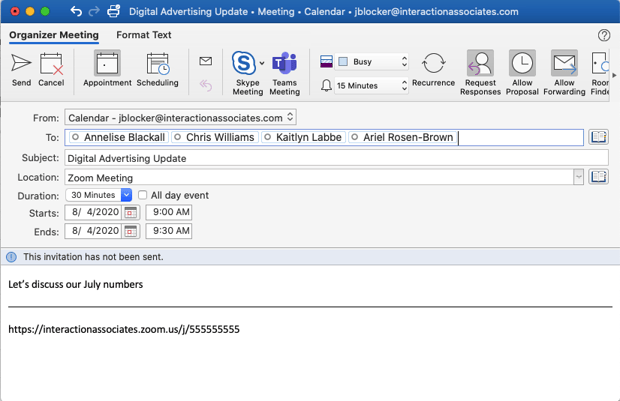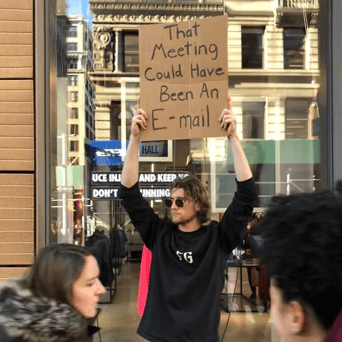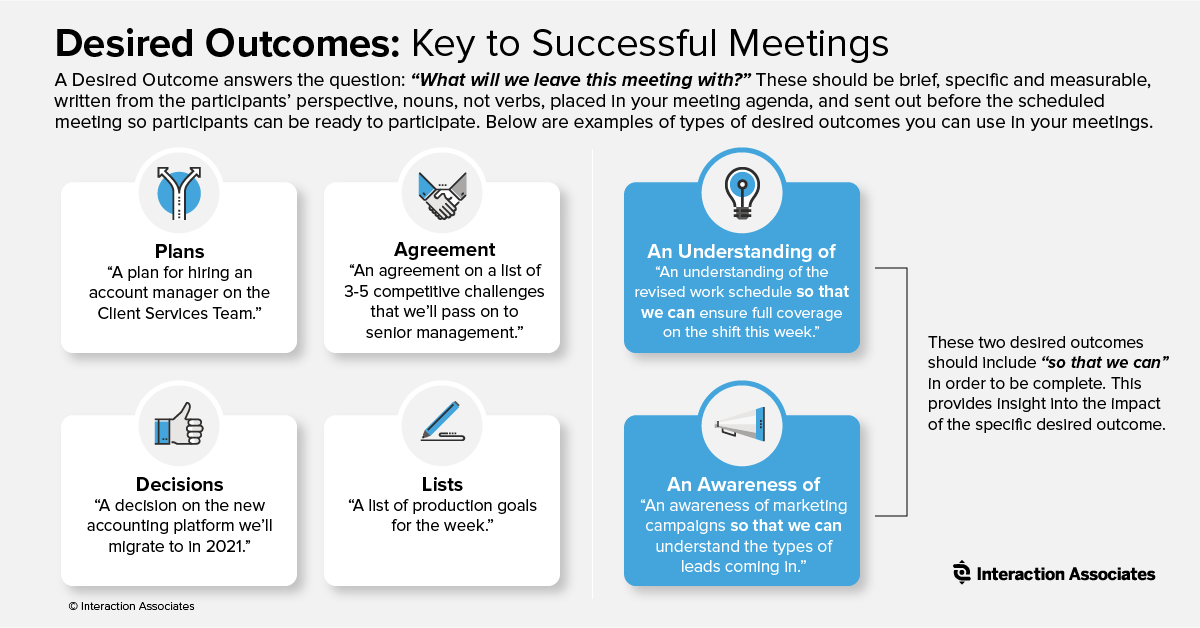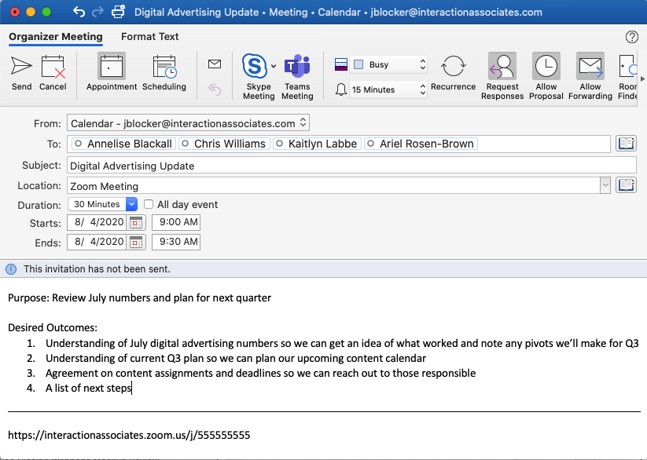IA Insights > Blog
Why Are We Meeting?
A few years ago, I attended a meeting at my previous company entitled “Marketing Update.” This wasn’t our weekly marketing team meeting. That 25-minute stand-up meeting usually ran pretty smoothly and productively. The invitation to this special meeting only had a title and a link to a virtual meeting room. No additional information. When the meeting started, several people from other departments were in the meeting. We spent ten minutes catching up with one another. Then the virtual meeting room fell silent. Jean, a marketing administrative associate spoke up after what seemed to be an eternity: “So what are we doing here anyway?” No response. Then Bill, a graphic designer, chimed in: “Who scheduled this meeting?”
Another ten minutes went by as the group pieced together the chain of events and issue that led to this particular meeting being held. That was a relief. But by then only ten minutes remained to discuss the issue. A few interesting ideas were shared. After the meeting ended, nothing happened with those ideas. No follow-through. The ideas went straight to the unproductive meeting cosmos.
Have you had an online meeting like this? This month? This week? Today?
In our introduction to the Online Meeting Monster™, a fictional character named Denise is mentioned. Denise is a terrific accounting manager but she’s a pretty awful meeting leader. She never has an agenda for her meeting. When people finally figure out what they’re trying to achieve, she doesn’t keep the meeting on track. The meeting I mentioned earlier was scheduled by a Denise, and the meeting behaviors I experienced are symptoms of the Online Meeting Monster™ being in the room.
The Online Meeting Monster™ is a cagy creature. It loves coming to online meetings, hanging out, and messing things up. The Monster isn’t dangerous, per se. It doesn’t generally make people sick. But it can take control of a meeting and lead it right into a dark closet or down the toilet.
To mitigate the common and frustrating behaviors and patterns exhibited by the Monster, or by people that the Monster has influenced, we’ve initiated a blog series entitled: Tame the Online Meeting Monster™. Throughout the series, we’ll provide tools and suggestions for navigating a group’s way through the three major phases of the Core Meeting Process™ -- Prepare, Lead, and Follow-through -- and for taming the Monster.
The first phase in the Core Meeting Process™ is Prepare. In this planning phase, you make conscious choices about stakeholder involvement, what the meeting aims to achieve, clarifying the decision-making process, and designing an agenda.
In this blog, I’ll cover a few of the choices in the Prepare Phase.
Purpose and Desired Outcomes
Two key elements often missing from meeting invites and agendas that are critical for meeting success are Purpose and Desired Outcomes.
How often have you sent or received a meeting invitation that look like this?

Let’s unpack this invite and the challenges it poses. As an attendee, the only understanding you have prior to the meeting is that you will “discuss” the previous month’s digital advertising numbers. You’re likely to be unclear about what the meeting aims to achieve and how you’ll be expected to participate. As the meeting leader who sent the invite, you will now have to spend the beginning of the meeting clarifying the purpose of the discussion, providing expectations of involvement, and hoping that everyone has enough time to compile thoughts (and data!) before they’re asked for input. In short, this meeting invite is too unfocused to be effective.
To set meetings up for success, we propose that every meeting invite should include both a statement of Purpose and Desired Outcomes.
1. Purpose
The statement of purpose answers the question, “Why meet?” Why are you bringing specific people together to discuss this topic? If you can’t answer this question, it’s time to reevaluate having the meeting in the first place.
 Seth Phillips, of “Dude with Sign” internet fame.
Seth Phillips, of “Dude with Sign” internet fame.
Common meeting purposes include:
- To identify, define, and/or resolve an issue.
- To solve a problem or explore an opportunity.
- To present an idea and get input.
- To inform stakeholders and answer questions.
- To develop a proposal or build a plan.
- To make a decision and identify next steps.
Try one of these purposes with the next meeting you’re scheduling. It should be specific to the context; make sure that if an attendee only saw the purpose, they would have a full understanding of why they’re being asked to attend.
2. Desired Outcomes
Identifying Desired Outcomes is my favorite practice that I’ve adopted since joining IA. The technique is so powerful that senior executives of organizations trained by IA have gone so far as to empower their employees to reject any meeting invite that does not include Desired Outcomes.
To put it simply, Desired Outcomes answer the question, “What will leave this meeting with?” Desired Outcomes are brief, written statements. They should be specific, measurable, written from the participants’ perspective, and must be nouns, not verbs. They reframe the conversation around what you aim to achieve versus what you aim to speak about.
In my Digital Advertising Update example, I want to use the July data so we can strategize our Q3 advertising plans and identify any pivots we may need to make based on what we’ve learned. I’m seeking attendees of the meeting to provide input on any strategy adjustment. The desired outcome I’ll use is: “An understanding of the July digital advertising numbers so that we can get an idea of what worked and provide input on any pivots we’ll make for Q3.”
Clear Desired Outcomes help attendees understand the leader’s expectations. They’ll appreciate this opportunity to prepare and won’t be surprised at any point during the meeting if asked to provide input.
To drive this to action, utilize the Desired Outcomes graphic as a reference when preparing for your next meeting.

Re-Crafting the Meeting Invite
Putting these two concepts into action have quickly transformed my previous meeting invitation:

Here the Purpose tells the attendee why they are meeting. The Desired Outcomes outline what they will be walking away with and even helps them set expectations for their own involvement.
Next Steps
I encourage you to start applying these simple practices as you plan your upcoming meetings. If you’re looking for a more comprehensive meeting agenda, download our Meeting Agenda Template that puts these practices on paper (literally).
If your organization is experiencing challenges with meetings, click here to learn more about Interaction Associates’ robust suite of solutions and how we’ve been the trusted partner to many of the world’s top organizations when it comes to taming the online meeting monster.
Did you miss a blog in the Tame the Online Meeting Monster™ series? Find the published blogs below:
Part 1: Meet the Online Meeting Monster™
This blog will introduce the monster and highlight key areas to look out for in your online meeting. We’ll be tackling each topic in the coming weeks.
Part 3: Is Anybody Listening?
Online meetings tend to have a lot of dead air and blank stares. In this blog we discuss how to overcome this common issue by keeping attendees engaged.
Part 4: Did You Write that Down?
A successful meeting should end with clear next steps and action items. In this blog we give tips on how to properly take meeting notes.
Part 5: Are We Done with This Meeting?
Tired of ending meetings more confused than when you started? Learn three simple practices that will help you end your meetings feeling confident.





